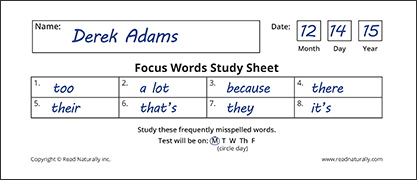If you were asked to list some of the words your students frequently misspell, I’m sure several words would immediately come to your mind—words that you have corrected over and over again. The first words that come to my mind are the words said and they, and I would guess those words are on your list as well!
What we know from research:
Actually, a small number of words—about 300—account for more than half the words students misspell in their writing. A Research in Action project reviewed 18,599 written compositions of children in grades 1–8 (Cramer and Cipielewski, 1995). The researchers noted spelling errors in these compositions and compiled the results. They found that a small set of common words tend to be misspelled over and over. These words are misspelled by students at primary, intermediate, and middle school levels.
The researchers for this project compiled a list of the 100 Most Frequently Misspelled Words Across Eight Grade Levels. The first ten words include too, a lot, because, there, their, that’s, they, it’s, when, and favorite. You will notice that many of the misspellings fall into these categories:
- The spelling and use of homophones—which constitute about 20 percent of the misspelled words (e.g., there spelled their).
- Words that contain an apostrophe—which make up about 10 percent of the misspelled words—some of which are also homophones (e.g., you’re spelled your, it’s spelled its).
- Words that lend themselves to inappropriate separation or joining (e.g., because spelled be cause, a lot spelled alot).
- Misspelling of compounds by wrongly separating them, or, less commonly, by wrongly joining an open compound or joining a compound with a hyphen (e.g., outside spelled out side, ice cream spelled icecream, baby-sit spelled babysit, etc.).
Here is some data that will not surprise most teachers: When researchers closely examined the first 25 most frequently misspelled words at each grade level, they noted a startling amount of overlap across grade levels one through eight. For example, when they compared the words missed in grade 3 with the words missed in grade 4, the correlation was .90. If the two lists were identical, the correlation would be 1.0. So, most of the words that were misspelled by third graders were still being misspelled by fourth graders. And, by grade 8, the correlation with grade 3 was .64. Even after five more years of instruction, students were still making errors on many of the same words.
The problem:
It is clear that the words primary-grade students misspell are in many instances the same words intermediate and middle school students continue to misspell. At the same time, an examination of a typical spelling curriculum will show that many of these frequently misspelled words are indeed taught fairly early. Unfortunately, it is also true that many of these words are taught only once within the span of an eight-year spelling curriculum.
So, if we know which words are frequently misspelled, and if we know that in a typical eight-year spelling curriculum these words may only be taught once, what are the implications for our instructional planning?
A strategy that works:
Try adding an additional feature to your normal spelling program. Assign your students Focus Words for the week. Choose up to eight words from the 100 Most Frequently Misspelled Words list. Be sure to select some words that you have recently observed students misspelling in their daily writing. At the beginning of the week, tell students they will be tested on these additional words following their regular spelling test, and tell students you will be monitoring their daily writing during the week to see if these Focus Words are spelled correctly.

As you select words for the following week, you can “recycle” any words that students missed the week before. For example, one year when I used this strategy with 2nd grade students, the words said and they continued to appear as #1 and #2 on the Focus Words list for 12 weeks in a row—until every student got those two words correct! Most of the other six words on the list were changing each week. The message was clear to my students—these are words we frequently use, and you must MASTER these words!
I put together some free resources if you’d like to try this idea with your class. Feel free to download the study sheet and test templates from our website—or design your own. Either way, by incorporating this easy strategy into your spelling instruction, you’ll save yourself a lot of red ink as you read through your students’ written work.
 See Also: Signs for Sounds: Read Naturally's Systematic Spelling Program
See Also: Signs for Sounds: Read Naturally's Systematic Spelling Program
_______, 1995. Spelling Research & Information: An Overview of Current Research and Practices. Glenview, IL: Editorial Offices, Scott Foresman and Company.
 Share your student’s success story—nominate him or her for our Star of the Month award. Win a Barnes & Noble gift card for the student and a Read Naturally gift certificate for your class!
Share your student’s success story—nominate him or her for our Star of the Month award. Win a Barnes & Noble gift card for the student and a Read Naturally gift certificate for your class!
Thanks for the great article and super useful resources for spelling, Karen! What a great time saving resource.